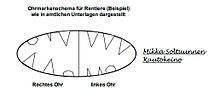Ear tag
An ear tag is used for the official identification and registration of pets and farm animals.
In the EU, all cattle , buffalo , goats and sheep must be marked with ear tags. In cattle and buffalo, one ear tag is attached to the right and left ear. Since July 2005 this also applies to goats and sheep, whereby the second ear tag can be replaced by another type of identification . In Germany pigs are to be identified with an ear tag.
Appearance in the EU
In the European Union , the labeling of the ear tag was stipulated by Regulation No. 2629/97. First, it contains the two-digit abbreviation of the Member State in which the establishment is located, where the animal in question was first identified. This is followed by a maximum twelve-digit numerical code that uniquely identifies the animal . The name, code or symbol of the competent authority or the competent central authority of the Member State which issued the ear tag is also given. An additional barcode may also be applied. The ear tags must be made of flexible plastic, be forgery-proof and not reusable. In addition, the information provided must be indelible and clearly legible throughout the life of the animal. As a cattle farmer in Germany, you are obliged to immediately replace lost ear tags.
Appearance at the Sami reindeer herders
Reindeer herders in "Lapland" (correct: Sápmi ) traditionally mark their reindeer with notches in the ears of the animals. Different combinations of small, larger and round notches are cut on the upper and lower edge of the ear. Both ears have different combinations of notches. The notch patterns are officially registered. This form of identification only allows assignment to the owner of the animal. The advantage, however, is clearly that apart from a knife, no other tool has to be used. Recently, however, ear tags similar to those in the EU have been used increasingly.
Attachment of ear tags
Ear tags are usually attached in the first days of life in order to be able to prove the exact identity and origin of the animal later. Since October 28, 1995, every cattle has been assigned a life ear mark number as an identity mark at birth.
In Germany, according to the Cattle Traffic Ordinance, labeling of cattle in the first seven days after birth, of sheep and goats in the first nine months and of pigs after weaning is to be carried out by the keeper or to be carried out, to whom the ear tags in advance by the responsible authority or authorized body have been assigned. If the animal loses the ear tag or if it becomes illegible, it must be replaced immediately; except during slaughter, it may not be separated from the body even after death without official approval.
Wild marks
Wild tags are used as ear tags to identify game in some federal states. "In the case of hoofed game that is intended for treatment in a carcass disposal facility, the wild tag is attached to the ear."
See also
Individual evidence
- ↑ Regulations (EC) no. 1760/2000 and 21/2004, see also the article Livestock Transport Regulation further references. as well as their annexes 4 and 9
- ↑ § 39 ViehVerkV
- ↑ § 27 Paragraph 1
- ↑ § 34 Paragraph 1
- ↑ Section 39, Paragraph 1
- ↑ Mecklenburg-Western Pomerania, Ordinance on the Proof of the Ingestion and Fate of Dead Hoofed Game and the Monitoring and Control of the Game Trade (Game Trade Surveillance Ordinance - WildHÜVO MV) § 2 Game Mark and Certificate of Origin


